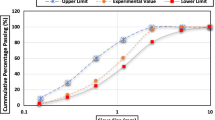Conclusions
-
1.
Vibroactivation and pregrinding of cement (especially in high-fill systems with low W/C ratio) enable us to create homogeneous, finely-crystalline, finely-capillary concrete.
-
2.
The structure-forming role of quartz microfiller in adhesive appears in the growth of the specific surface of the pore capillaries and the proportion of fine pores.
-
3.
As more quartz is added up to the optimal quantity, the structure of the adhesive improves. Above this limit the proportion of coarse pores begins to increase, together with the overall porosity, owing to excess of water for the case W/S=const, or owing to incomplete compaction at constant water-cement ratio. For the compositions investigated (W/S=const) the best amount of added quartz is 20–30%.
-
4.
Vibroactivation of high-fill systems based on finely-ground cement and the addition of quartz microfiller up to 40% secure high water-imperviousness of colloidal cement adhesive and solutions based on it.
-
5.
The experimental data on the pore structure and water imperviousness show that CCA and CCS can be successfully used as waterproofing materials.
Similar content being viewed by others
Literature Cited
P. A. Rebinder, Physicochemical Mechanics: a New Branch of Science [in Russian], Znanie (1958).
P. A. Rebinder and N. V. Mikhailov, The Basic Principles of the Physicochemical Theory of Concrete and Suggestions, Based on Its Conclusions, for the Technology of Concrete [in Russian], NTO Promyshlennosti Stroitel'nykh Materialov SSSR (1956).
N. V. Mikhailov, The Physicochemical Theory of Concrete and the Basic Principles of the New Technology of Concrete and Reinforced-Concrete [in Russian], Gosstroiizdat (1958).
N. B. Ur'ev and N. V. Mikhailov, “Colloidal Cement Adhesive and Its Use for Cementing Together and Rendering Monolithic Concrete and Reinforced-Concrete Constructions and Structures,” Ékspress-informatsiya, Seria “Stroimaterialy,” Kishinev (1961).
N. B. Ur'ev and N. V. Mikhailov, Handbook: Physicochemical Mechanics of Disperse Structures [in Russian], Nauka (1966), pp. 287–290.
N. B. Ur'ev and N. V. Mikhailov, Colloidal Cement Adhesive and Its Uses in Building [in Russian], Stroiizdat (1967).
N. B. Ur'ev, A. F. Klimanova, and N. V. Mikhailov, “Investigation of injection solutions based on colloidal cement adhesive for rendering monolithic the elements of hydraulic structures,” Gidrotekh. Stroitel'., No. 1 (1967).
S. R. Yasovskii, N. B. Ur'ev, and N. V. Mikhailov, Stroitel, No. 11 (1964).
Yu. Ya. Shtaerman, Vibroactivation of Cement [in Russian], Tbilisi, Tekhnika da Shroma (1957).
G. S. Khodakov, L. I. Édel'man, and G. G. Kornienko, “Study of the specific surface of the solid phase in the process of hardening of mineral binders,” Kolloidnyi Zhurnal,24, No. 3 (1962).
Yu. V. Chekhovskii, Reducing the Perviousness of Concrete [in Russian], Stroiizdat (1968).
Z. N. Tsilosani, Shrinkage and Creep in Concrete [in Russian], Izd. AN Gruzinskoi SSR (1963).
T. Yu. Lyubimova, Handbook: Physicochemical Mechanics of Disperse Structures [in Russian], Nauka (1966), p. 268.
S. N. Popchenko, G. A. Nechaev, and V. V. Tokmakov, “Proceedings of Coordination Conference on Hydrotechnics,” Énergiya, No. 43 (1968), p. 121.
G. A. Nechaev and I. S. Dubinin,ibid. “, p. 282.
Additional information
Translated from Gidrotekhnicheskoe Stroitel'stvo, No. 5, pp. 15–18, May, 1970.
Rights and permissions
About this article
Cite this article
Klimanova, A.F., Dubnikov, L.M., Ur'ev, N.B. et al. The pore structure and waterproofing properties of colloidal cement adhesive and solutions based on it. Hydrotechnical Construction 4, 404–408 (1970). https://doi.org/10.1007/BF02376136
Issue Date:
DOI: https://doi.org/10.1007/BF02376136




